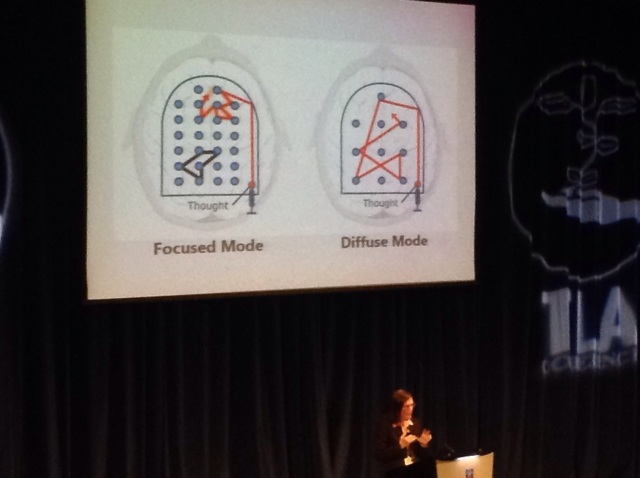Oakley is a Professor of Engineering who is a visiting scholar in California and is speaking on the topic, learning how to learn.
She starts by explaining that a favourite hobby of hers is to watch people, and how important it is to get in touch with yourself and your students’ selves. She explains that having moved around a lot as a child, she resigned herself to never grasping maths. So, how did she change herself? She’d been a really not technical person as a child, and had aimed to learn a different language. Because she had no money for college, she joined the army, and learned Russian. She always loved having new perspectives and different adventures, but in some ways the path was always comfortable and familiar. She wondered if she could teach herself what the engineers and scientists she had met knew, and at 26, set out to do that.
How?
The brain has two different mode – focused, and diffuse.
In diffuse mode, it is easier for a new idea to get to the place where it needs to go to be solved. So, when you’re stuck on a problem, you need to stop and step away, to diffuse your attention.
Barbara talks about Salvador Dali, who used to sit in a chair and relax and relax until a key he was holding dropped from his hand, clattering and waking him up, which brought his ideas in from the diffuse mode back to the focused mode, where he could process them. Edison did something similar with ball bearings. These different modes of thinking are important in any kind of problem solving. Focusing intently in one session is not the best way to solve a problem. Trying to do this makes procrastination a habit, and procrastination is addictive. Instead, follow the pomodoro technique. Set a timer for 25 minutes and turn everything else off. Focus intently for 25 minutes. At the end, relax, for a few minutes or however long you can spare. This enhances your ability to focus. Learning continues at the end of the focus period, learning will continue, thought you may not know it. It’s important note to focus on finishing a task; make subtle changes – introduce it gradually, rather than doing it 15 times in a day or something.
Sleep is also really important. This reminds me of that excellent ted talk about how the brain is washed of the remains of the daily thoughts, which helps you think more clearly. New synapses form when you sleep after learning, thus proving that learning a bit every day instead of cramming is a more effective way of learning – she mentions spaced repetition, a good crossover from David Fawcett’s session. These new neurons need to be used, or they will die – but exercise also has a positive impact on neuron retention.
Working memory. Thinking of other things takes up slots in your working memory, so you can’t concentrate as hard or remember as much.
How do we transfer from working memory to long term memory? Practice. It helps build the synaptic connections so you can more easily retrieve it at the end. They need to be knit together which will allow you to better understand and remember the whole – like learning to reverse in a car, until you get used to doing several things at once, it is messy.
Swift thinkers vs slow thinkers. Race car drivers get there first, but hikers get to notice more – slow thinkers are less likely to jump to conclusions.
Students have illusions of competence in learning, so test frequently and test often. Flash cards are your friend. One of the most effective ways of learning is recall – read the page, look away and see what you can remember. This is more effective than re reading. Interleave – don’t do the same types of problems over and over again. Study with classmates – but judiciously.
We are often told to follow our passions, but they are a double edged sword. They develop around what we are good at, but some things take a long time to get good at, so passions don’t develop around them. Don’t follow your passions – broaden your passions.
She shares details of the mooc, on the UC San Diego website.
Here’s the advice as I see it, then:
Sleep.
Exercise.
Build in periods of focus and periods of relaxation.
Test, test, and test again.
She mentions knitting several times, by the way. All the best people knit.


Pingback: History revision for parents | High Dive Teaching